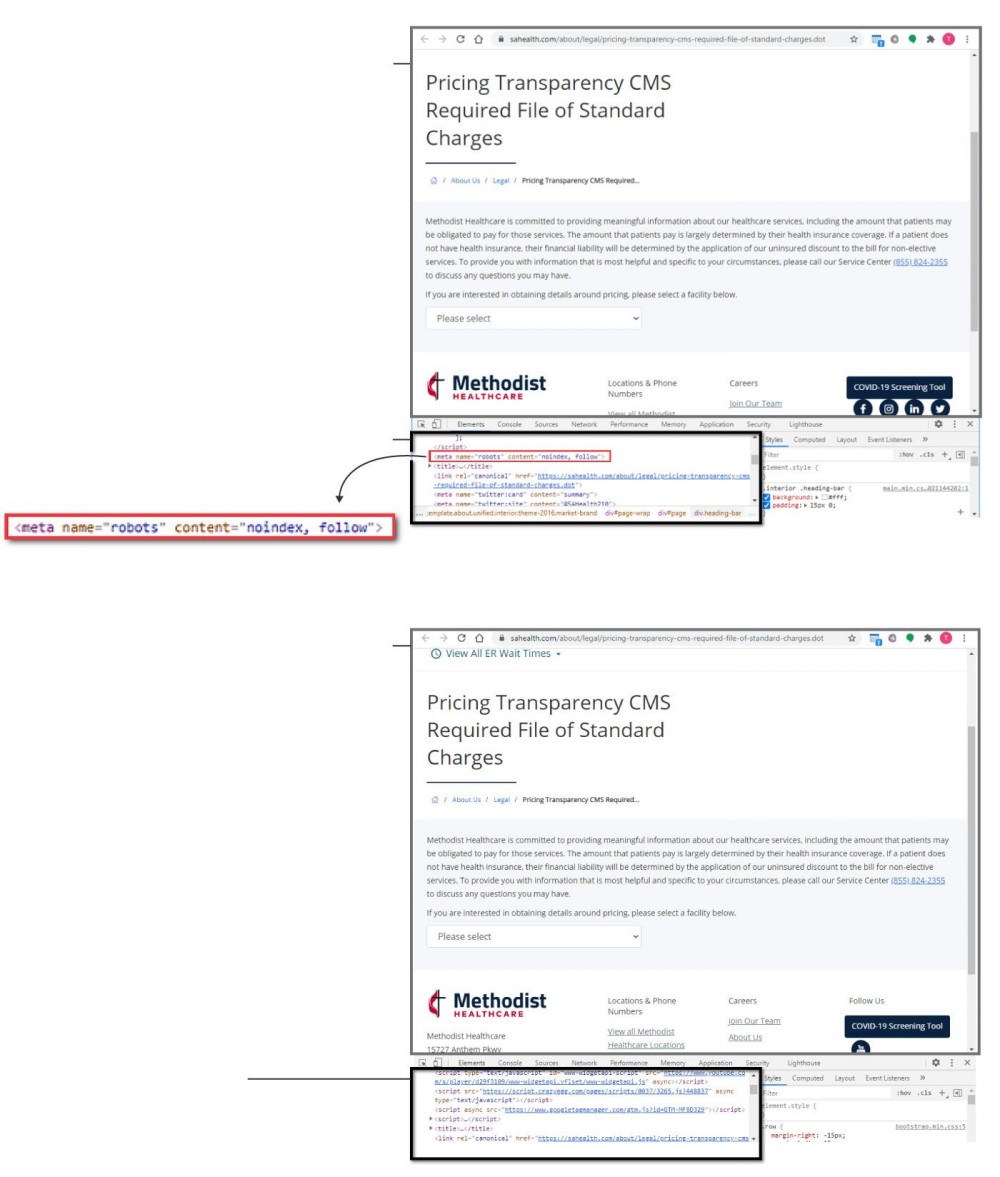A recent investigation has discovered that hundreds of hospitals have been intentionally removing pricing data from Google searches, despite a January 1st Federal law requiring them to make this data public.
The Problem With Secret Healthcare Prices
One of the biggest problems with the American healthcare system has been transparency; patients have no idea how much they’ll be charged for care until after they receive it. Under a federal law proposed by President Trump and signed into law on January 1st, hospitals are now required to make their pricing easily accessible to patients.
This is extremely important. Unlike virtually every other service provider in the world, hospitals have been able to keep their prices secret… until now. And for good reason. When a woman gets a caesarean section at the gleaming new Van Ness location of Sutter Health’s California Pacific Medical Center, the price might be $6,241. Or $29,257. Or $38,264. It could even go as high as $60,584.
The fact that the same services – by the same providers at the same facility – could be ten times more expensive based on your insurance plan is an absurdity that is exclusively possible because of the secrecy surrounding price policies. In fact, Americans spend over $3.6 trillion each year on healthcare… nearly 20% of our GDP.
Under Trump’s new law, hospitals and other care providers are required to make the cost of all services easily accessible to patients. This means that patients can compare the cost of care across different hospitals, choosing the most affordable option. It also provides transparency that allows insurance companies to negotiate better deals for their clients.
In the case of Sutter Health, some cardiac procedures ranged from $89,752 to $515,697, depending on the insurance plan. That’s a 574% markup on potentially life-saving procedures simply based on your insurance provider. A hip or knee replacement, which are performed over a million times each year in the U.S., may cost you around $4,500 or nearly $80,000. It all depends on the deal your provider was given.
Although the new transparency law went into effect at the start of 2021, hospitals have been slow to comply. Officials overseeing New Jersey’s employee-health plan, which covers around 800,000 people, found “a disappointing patchwork of willful noncompliance and attempted compliance that is not in the spirit of the rule.”
The new rule requires hospitals to release prices for all services. Hospitals typically have a sticker price, which can be a starting point for discounted rates they negotiate with insurers. Hospitals also have cash prices for the uninsured. The new regulation requires disclosure of those rates, in addition to the insurers’ prices.
The rule also says that the data file with all of the rates has to be displayed prominently on a public website, and that a hospital has to ensure the data “are easily accessible and without barriers.”
Hospitals that violate the rule face a penalty of up to $300 a day.
But it appears that hundreds of hospitals are still trying to circumvent the transparency law, using Google search parameters in their website code to hide the data.
A Malicious Cover-Up
According to a new investigation by the Wall Street Journal, hospitals that have published their previously confidential prices in order to comply with this new federal rule have also blocked that information from web searches with special coding embedded on their websites.
It’s a clear indication of intentionality.”
As we’ve discussed, this information must be disclosed thanks to Trump’s federal rule aimed at making the $1 trillion healthcare sector more consumer friendly. But hundreds of hospitals have embedded code in their websites that prevented Google and other search engines from displaying pages with the price lists.
The code, content=“no index” keeps pages from appearing in searches, such as those related to a hospital’s name and prices, computer-science experts said. The prices are often accessible other ways, such as through links that can require clicking through multiple layers of pages.
“It’s technically there, but good luck finding it,” said Chirag Shah, an associate professor at the University of Washington who studies human interactions with computers. “It’s one thing not to optimize your site for searchability, it’s another thing to tag it so it can’t be searched. It’s a clear indication of intentionality.”
Think of it this way:
When you build a website, search engines like Google routinely comb through the site to generate search results. If you search for “vitamin d” within thetruthaboutcancer.com, you’ll find several pages within our site that reference vitamin D. But a simple line of code can instruct Google and other search engines to ignore that page, making it impossible for you to find the information without navigating directly to it.
And that’s what hundreds of hospitals have been doing. After begrudgingly posting their pricing data, these healthcare systems have been going out of their way to ensure that patients like you and me won’t be able to actually find the information we need.
Among websites where the Journal found the blocking code were those for some of the biggest U.S. healthcare systems and some of the largest hospitals in cities like New York and Philadelphia. They include hospitals owned by HCA Healthcare Inc., Universal Health Services Inc., the University of Pennsylvania Health System, and NYU Langone Health. Some regional systems also had such code on their websites, including Michigan’s Beaumont Health and Novant Health in Winston-Salem, N.C.
Penn Medicine, NYU Langone and Novant Health said that they used blocking code to direct patients first to information they considered more useful than raw pricing data for which they also included links. Universal Health uses the blocking code to ensure consumers acknowledge a disclosure statement before viewing prices, said spokeswoman Jane Crawford.
“We are making NO efforts to hide any information,” Ms. Crawford said in an email.
But experts agree that the “no index” code is rarely used, and always removed once a page has been built. The idea that hundreds of hospitals “accidentally” ended up with code hiding the exact pages that they don’t want patients to see tests the limits of human imagination.
Hospitals Backpedal After Being Caught
After the Journal approached hospitals about its findings, the search-blocking code was removed from sites including those of HCA, Penn Medicine and Beaumont, and of South Dakota-based Avera Health, Tennessee-based Ballad Health, Maine’s Northern Light Health and Gundersen Health System in Wisconsin.
An HCA spokesman said the search blocker was “a legacy code that we’ve removed.” Avera, Ballad, Beaumont and Northern Light said the code had been left on their websites by mistake. A Gundersen Health System spokesman said a website vendor had inserted the code. “It’s not clear why,” he said.
Computer-science experts said such code can be used during web page development to prevent search engines from storing an incomplete copy as a backup, known as a cached copy. The code is typically removed when a page is completed. Some hospital owners said they had recently completed their pricing-data pages to comply with the rule.
Federal officials who developed the price transparency regulation said the data could help consumers to find better deals and help doctors and employers to select the hospitals where they steer patients for service. The use of blocking code is one way hospitals have fallen short of the rule’s requirements, experts on the new regulation said.
When confronted with their crimes, the corrupt medical industry did what it does best: LIE.
To identify web pages hidden from search results, the Journal wrote a program that read the contents of 3,190 disclosure pages whose addresses were provided by Turquoise Health Co., a startup working with the price-transparency data. The program searched for a tag in the pages’ background coding that instructs search engines not to index the page.
The Journal found 164 web pages hosting disclosure files for 307 hospitals that contained versions of that blocking syntax. Some pages include information for more than one hospital within a system. The code was removed from pages with data for 182 hospitals after the Journal contacted their owners.
Let me say that again:
About 10% of hospitals reviewed were hiding price data. Of those, nearly two-thirds deleted the code once reporters confronted them.
“They’re taking an active step to make something harder to find,” said Thomas Barker, a healthcare attorney at Foley Hoag and former official at the Department of Health and Human Services. “I would say it violates the spirit of the rule.”
Remember, hospitals are required to ensure the data “are easily accessible and without barriers.” I’d say that writing code into your webpage to block search engines from finding it violates that mandate. And blocking search results is just one of the ways that hospitals try to hide this important information from us.
Despite Federal Law, Hospitals Refuse to Play By the Rules
Turquoise, which has searched for price disclosures on the websites of U.S. hospitals since Jan. 1, has found that many facilities are falling short of compliance with the new rule. Some 45% of the 2,267 short-term, children’s, and rural hospitals that Turquoise has rated so far scored a three or lower on the company’s five-point rating of compliance. Many hospitals with low ratings disclosed only sticker prices for procedures, not actual rates negotiated with insurers.
NYU Langone is among hospital operators that posted only sticker prices. “We are continuing to work on meeting the new requirements,” an NYU Langone spokeswoman said.
Houston Methodist hasn’t posted negotiated rates. The eight-hospital system has posted sticker prices and average charges for certain inpatient services, but the pages containing those files include the blocking code. A spokeswoman said Houston Methodist believes listing the negotiated rates would be confusing and misleading. The available pricing data can be found through a web search, she said. An adjacent site does appear in searches.
Some hospitals list prices in spots on their websites that require many scrolls or clicks to reach. That can make the information hard to find, computer-science experts said.
“The more clicks or scrolls it takes to get something done is a pretty good predictor of how many people will succeed,” said Ben Shneiderman, a professor emeritus of computer science at the University of Maryland.
UPMC, a 40-hospital system based in Pittsburgh, has placed the price lists on each hospital’s website, which can require seven clicks to reach from UPMC.com. A user navigates through links with labels including “Locations,” “Hospitals,” “Patients & Visitors,” and “Patient Information” to reach them. UPMC, which removed blocking code from price-data websites for two hospitals after the Journal reached out, didn’t include the negotiated commercial rates for insurers in its data. The health system did offer other data points required under the rule, such as sticker prices and cash prices.
Censorship and the Medical Mafia
The truth is that foul play like manipulating online search results is par for the course when it comes to the medical establishment. Despite what this trillion-dollar industry would have you believe, U.S. healthcare is about profits, NOT patients. And keeping vital information out of the hands of patients is on the first page of the healthcare playbook.
When I tell the story of how Ty and I first started The Truth About Cancer, I first share how we lost several family members to cancer… or rather the prescribed treatments for cancer. But the reality is that they died because of censorship. Without access to all of the information we needed, our options became severely limited.
This pricing cover-up is just another example of that censorship. Hospitals don’t want you to know what they charge for stitches, knee replacements, baby deliveries, or overnight stays. They also don’t want your insurance company to know what kind of rates their competitors have negotiated.
Why?
Because that would force them to be competitive. Because that might create an environment in which health care truly becomes affordable for the average American. Because honesty will hurt their bottom line. Here’s a breakdown of how much money the top executives at Hospital Corporation of America made in 2019:
Jonathan B. Perlin, M.D. – Chief Medical Officer: $3,588,875
R. Milton Johnson – Executive Advisor: $3,777,878
Jon M. Foster – President of the American Group: $4,353,542
Charles J. Hall – President of the National Group: $4,742,962
William B. Rutherford – Chief Financial Officer: $6,323,179
Samuel N. Hazen – Chief Executive Officer: $17,206,908
That’s a grand total of roughly $40 MILLION DOLLARS to just 6 high-level executives each year. And that’s not including stock awards. Extra compensation brought CEO Samuel Hazen’s gross income to 26.8 million dollars during his first year on the job. That’s 478 times more than the average HCA employee made that year.
And yet, this seemingly thriving company has gone out of its way to hide essential pricing data from patients and insurance companies; an act that is both morally and legally objectionable. And while executives and shareholders reap the rewards, patients and their families are dying – both literally and figuratively.
A 2007 study found that 62.1% of bankruptcies were caused by medical issues. Another claims that over 2 million people are adversely affected by their medical expenses. The medical industry is a racket, exploiting the people that need help the most. And although they’ll claim that this corrupt coding cover-up was an accident, history has told us that sneaky, greedy behavior is the standard, not the exception.
These companies should be prosecuted under the new law, fined, and required to make restitution to the tens of thousands of patients they’ve deceived since the new law was put in place. The next time you go to the hospital (or look at your insurance bill), remember that these companies are willfully violating the law while proverbially spitting in the faces of their patients… all in the name of the almighty dollar.




















I have seen this first hand. But fortunately I have Christian Healthcare Ministries. These folks fight for you, the patient, and get the best negotiated prices even if you, the patient can’t. The truth is if people would have to pay upfront for services then send to insurance for payment back to them, this would be less if a problem because they would scrutinize the bills and realize that many times they are being charged for things they never received. The medical establishment is as corrupt as any other big business. And until folks stand up to them, their deceptive practices will continue. I so appreciate TTAC for all you do and stand for. Please keep it up.
This makes me mad. Over a year ago my son, who works with cyclotrons used for the treatment of prostate cancer for a large University medical system in Atlanta, told me about this full disclosure of prices law and was celebrating it and its benefit. I was an RN in various capacities during my 50+ year career. I agree that our medical and illness treatment system is focused on its bottom line much more than on wellness of people/patients/customers.
There has always been many options to treat all kinds of chronic illnesses, but doctors want their patients to go the conventional way because they make a big profit. Doctors do not make money using alternative therapies and natural medicine because Big Pharma does not make a profit.
Thanks for this eye-opening article, Mrs Bollinger.
Thank you so much Ty and Charlene for publishing this article. For years I have known our health industry is a cold blooded bunch concentrating only on how much they can rob the insurance companies for the horrible treatment they give patients. I had my mother killed because of a treatment they gave her during the 6 hours I was gone away from her to rest. The whole system is a mafia. Thank you so much Charlene and Ty.
PS Hospitals kill almost 1M people in a year and give patients unnecessary expensive treatme to fill their pockets. Shame on them! They should be put in jail!